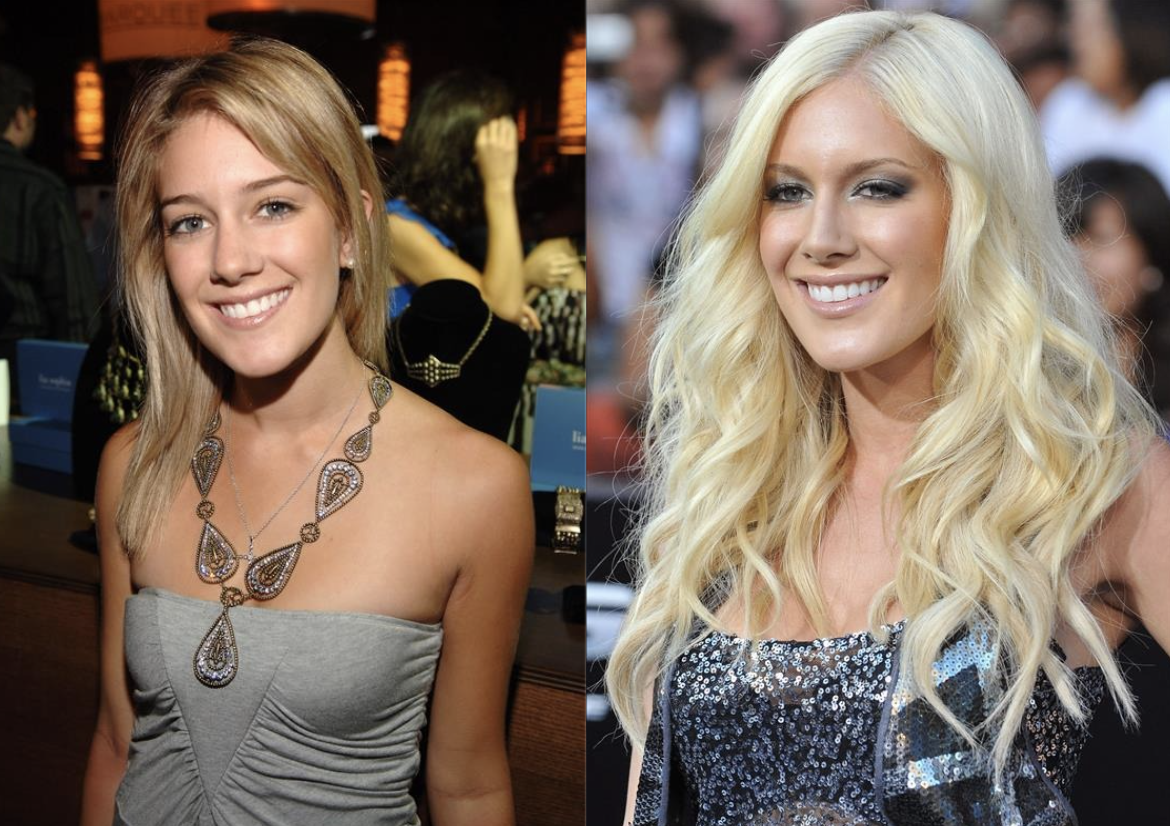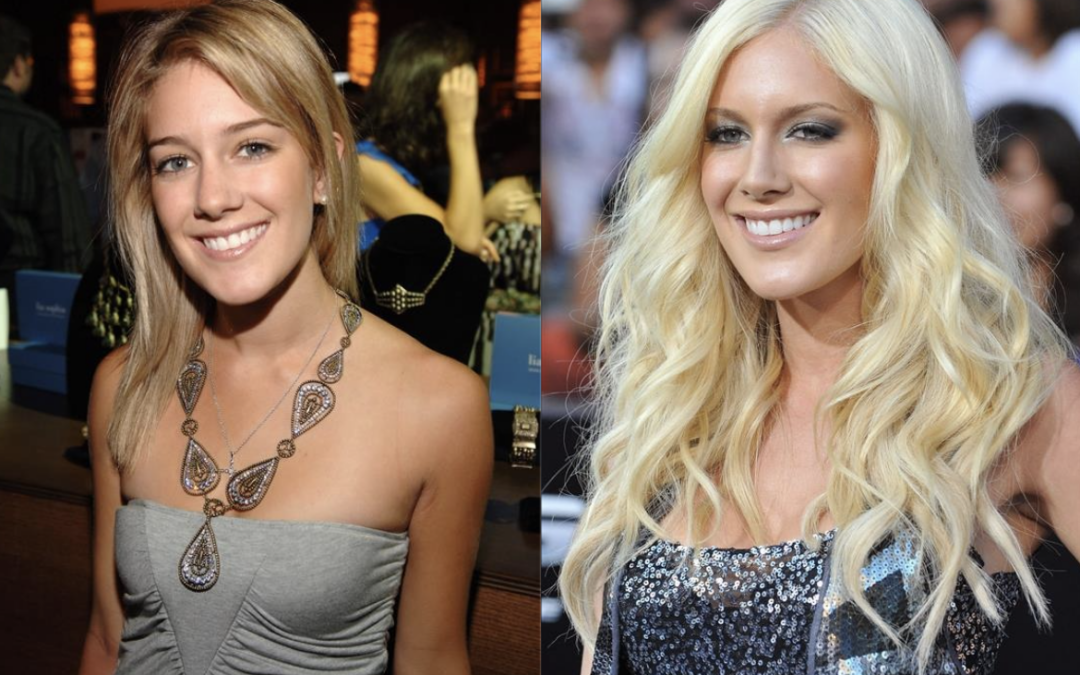How Heidi Montag became a marker for a seismic shift in beauty standards
It’s been 15 years since the moment she broke the internet.
Words by Nikki Peach

When Heidi Montag debuted her plastic surgery transformation on The Hills in 2010, it was called everything from ‘heartbreaking’ to ‘tragic’ and ‘obsessive’. Viewers watched Montag, then 22, return to her hometown in Colorado to tell her disapproving mother Darlene Egelhoff about the 10 surgeries she had endured over one day.
‘I got a slight eyebrow lift and that’s why I had these staples in my head,’ she said. ‘I had my nose redone. I had my own fat injected into my cheeks. I had my ears pinned back. I had injections in my lips. I had my chin shaved down. I had my breasts redone and my back shaped and then I had a little bit of inner and outer lipo[suction] done.’ Visibly very upset, Egelhoff told her, ‘You risked your life to do the things that you did. You had elective surgery that was completely unnecessary.’ To which Montag replied, ‘To you it was unnecessary.’
The episode, which was watched by 2.7 million viewers in the US when it first aired, turned Montag into a tabloid punch bag. She was labelled ‘addicted to plastic surgery’, told her new look was ‘career ending’ and that it was evidence she was ‘mentally ill’. Fifteen years later, the clip of that episode has gone viral on TikTok, but the responses are very different indeed.
‘She looks amazing lol mom is jealous,’ reads one comment. ‘It looks so natural,’ reads another. While a third wrote, ‘She looks perfect, I’m confused.’ There is even a Reddit thread dedicated to the discussion. ‘I just saw some pictures of Heidi Montag from back in the day and was surprised to see how “normal” she looks for today’s standards,’ it reads. Some responded to say Montag was ‘ahead of her time’, while others noted ‘what she had done is the minimum order to be on reality TV’ today.
This is something that beauty critic and columnist Jessica DeFino calls ‘aesthetic inflation’: the gradual normalisation of cosmetic procedures that were once considered extreme. ‘What was unique for Heidi 15 years ago is borderline “boring” today,’ DeFino argues. ‘People transform their faces all the time, whether with cosmetic work or Instagram filters or Face- Tune and the public is used to seeing this.’
‘I just saw some pictures of Heidi Montag from back in the day and was surprised to see how “normal” she looks’
A seismic shift in beauty standards has taken place in the past 15 years – which DeFino says is fuelled by a number of factors, including the rapid development of new cosmetic technology ‘and the democratisation of this technology. Once reserved for the very wealthy, now more people can access more expensive treatments with Buy Now, Pay Later programmes or by taking on cosmetic debt.’
The ubiquitousness of social media has also blurred the line between celebrity and the average person – ‘we all exist in the same space and are judged by the same standards’, DeFino continues. Lydia Badia, a consultant surgeon in facial plastics at Rhinoplasty London, agrees that ‘intensified self-scrutiny’ has lead to an aesthetic shift. ‘Many people now view cosmetic procedures as a common aspect of self-care. The idea of boosting self-confidence and therefore emotional wellbeing is seen as a positive. A change in appearance is now considered a way to “shake things up” and feel more motivated to start a new phase in life.’
Knowing the measures she took to achieve her beauty ideals, for Montag’s appearance to be considered ‘natural’ is a tough pill to swallow. Our moral stance on cosmetic surgery might have changed, but there is still truth in her mum’s initial response. Speaking to Paper magazine in 2018, Montag admitted she ‘died for a minute’ during surgery. ‘I had to have 24-hour nurse care,’ she explained. ‘My security guards called Spencer and told him, “Heidi’s heart stopped. She’s not going to make it.” And I easily could’ve. Cutting yourself up isn’t something I’d recommend.’
Evidently, the dangers are not a deterrent. In the UK, 27,462 cosmetic surgical procedures were performed in 2024 – a 5% increase on 2023 – of which more than nine in 10 were on women. According to the British Association of Aesthetic Plastic Surgeons (BAAPS), much of the rise was driven by increases in facial ‘rejuvenation’ surgery, such as face and brow lifts. The association’s president, Anthony MacQuillan, chalks the rise up to surgery becoming cheaper and easier to access, with patients saying there is also less stigma.
But there’s a flip side, says DeFino. ‘Whereas Heidi faced a lot of criticism for going under the knife 15 years ago, the normalisation of this level of surgery has made it so women face more criticism today for not meeting the standard of beauty. The gulf between what is considered beautiful and what the average person naturally looks like is widening. Today’s baseline standard of beauty relies so heavily on procedures, treatments and tweakments, it’s now harder for women to opt out of spending their time, money and energy on this aesthetic labour.’
So, where will aesthetic inflation take us next? ‘Demands [for procedures] will always change depending on evolving cultural trends,’ warns Badia. While some fear the rise of AI-created imagery will drive beauty standards into dangerous territory, Badia thinks AI advances will make people more aware of ‘fake results’. Could the pendulum swing back to celebrating ‘real’ untouched faces? Ask us in 15 years…
Photos: Getty

